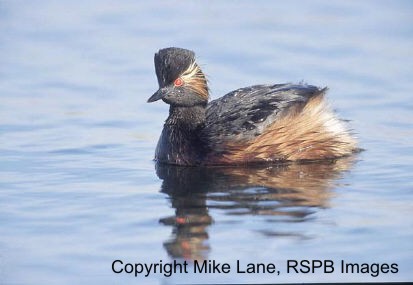BLACK-NECKED GREBE (PODICEPS NIGRICOLLIS)
LOCAL BIODIVERSITY ACTION PLAN
Links to associated HAPs
Meres
 Current Status
Current Status
A rare breeding species in the UK, the national population fluctuates between 20 and 40 pairs annually. The region was colonised in the early 1980s and Cheshire and neighbouring Greater Manchester now holds up to 20% of the UK breeding population. Various natural meres and shallow, man made water bodies, characterised by substantial areas of emergent and floating vegetation, have the potential to be colonised by breeding black-necked grebes in the future. The wintering grounds of the northwest England breeding population are currently unknown. Currently breeding at two sites. Popn. stable at 1-2pairs at first site, and increasing at second site with c25 pairs.
The colony at Woolston Eyes continues to grow in size and is now the largest breeding colony in the UK. There has been a record breeding count in 2001, 36 adults in May and probably 20 pairs nested raising over 20 young. In both 1998 and 1999 breeding was restricted to 2 sites but the population increased markedly from 17 birds in 1997 to 29/30 in 1998 and over 30 in 1999. Breeding was confirmed in 1999 at two sites and 32 adults summered. A minimum of 9-10 birds are thought to have bred, fledging 15 young. This puts productivity at 1.5-1.66 young/pair.
Black-necked grebes are afforded special protection at all times under Schedule 1 of the Wildlife and Countryside Act. 2 of the current breeding sites are designated as Sites of Special Scientific Interest (SSSI).
Threats
-
Draining of natural wetlands.
-
Lack of positive management. Many of the region's man made wetlands are often ephemeral in nature. Unless managed, open water and emergent aquatic communities dry out through natural succession and develop into damp, willow scrub.
-
Loss of man made wetlands to developmental pressures, i.e. landfill, new housing.
-
Sensitivity to disturbance in the breeding season. The increase in recreational activities such as angling and sailing has reduced the numbers of sites suitable for this species.
-
Low breeding success at certain sites requires further study.
-
Restriction to a few isolated sites leaves the population vulnerable to chance events.
-
Predation.
-
The long-term future of the Number 3 deposit bed at Woolston Eyes is still uncertain and could be threatened by new pumping of canal sewage.
-
Potential long term loss of main site due to operational nature of site.
- Need for replacement habitat
- Industrial development of Shell Pool
- Sludge pumping at Woolston Eyes
- Predation by unknown predators
How are we helping to conserve the Black-necked Grebe in the Cheshire region?
-
A North West England Black-necked Grebe study group has been monitoring the species for a number of years.
-
Site occupancy, population levels and breeding success are recorded in an annual monitoring report.
-
Liaison with other black-necked grebe monitoring groups elsewhere in the UK.
-
RSPB undertaking national study of preferred habitat requirements.
Objectives, Targets and Actions
OBJECTIVES |
LOCAL TARGETS |
Monitoring existing sites, habitat enhancement and creation. |
Targets awaited |
ACTIONS REQUIRED |
-
Maintain breeding populations of black-necked grebe on at least 4 sites and seek to increase the number of breeding sites to 6 by 2005.
-
Ensure suitable nesting habitat is created at a number of sites across the region by 2005.
-
In the short term maintain a regional breeding population of no less that 7 pairs and seek to increase this to 15 pairs by 2005.
-
Carry out further research into the breeding ecology and habitat selection of black-necked grebes.
-
Complete the publication of a manual on habitat creation for breeding black-necked grebes.
-
Disseminate the above report to privatised water companies, industries associated with artificial wetland creation, i.e. sludge and lime beds, gravel and sand quarrying companies and riparian landowners.
-
In partnership with private businesses identify sites for the specific creation of black-necked grebe 'prescription' wetlands.
-
Ensure effective site security at current breeding sites which suffer from disturbance.
-
Consider the need for the introduction of legal mink control at certain current breeding sites.
-
Ensure that all existing breeding sites and any future sites created for black-necked grebes produce a written management plan which incorporates the requirements of this species.
-
Implement the management recommendations made after the 1998 aquatic invertebrate survey.
-
Form links with the Meres BAP.
-
Approach the new owners of a nearby site, which is frequently visited by black-necked grebe but currently unsuitable for breeding, with a view to entering the Countryside Stewardship scheme to enhance the aquatic macrophyte habitat for nesting.
-
Meeting convened with English Nature and other interested parties to discuss low breeding productivity at Woolston Eyes.
-
Annual monitoring to continue.
-
Discussions with English Nature re: designation of Shell Pool in Greater Manchester as a SSSI.
|
Progress so far
1997-2005 Action Completed |
-
A questionnaire on the habitat requirements and ecology of breeding black-necked grebes was sent to recorders of all breeding sites in the UK. The results are being analysed to produce a manual on habitat creation.
-
An annual monitoring report was produced in 1998 and circulated to other monitoring groups.
-
All current and historic breeding sites were checked in 1998/99 and 1999/00. The annual monitoring programme was undertaken successfully in 2000/2001.
-
Positive wetland management is being undertaken at 3 of the current breeding sites. This has included the transplanting of amphibious bistort in 1999/00 to increase suitable nesting habitat.
-
Detailed aquatic invertebrate sampling was carried at 3 of the 1997 breeding sites. This has resulted in recommendations for improving the abundance of chick food supplies.
-
40 acres of new wetland habitat has been created for the black-necked grebe at one site.
-
£50,000 was secured through landfill tax for the creation of a new 17-hectare wetland complex at one of the breeding sites. Approximately a third of the work was completed in 1998 with the rest being completed in 1999.
-
Another breeding site has been accepted into the Countryside Stewardship scheme.
-
A tower hide was constructed at one site in winter 1998/99.
-
The new wetland, designed for black-necked grebes, on Woolston Number 4 bed, was successfully entered into the Countryside Stewardship scheme and the first black-necked grebe was recorded on the site during autumn post-breeding dispersal in 2000. Monitoring current numbers.Main site is managed under CSS, and includes new habitat creation.
-
Landfill tax bid submitted in July 2001 to fund a new tower hide in Number 3 bed at Woolston Eye.
-
Monitoring of all current and past breeding sites in Cheshire and Greater Manchester took place in 2004.
-
The Annual Report for 2003 was produced in draft form.
|
How to find out more about Black-necked Grebes
Visit the RSPB website - www.rspb.org.uk/birds/guide/b/blackneckedgrebe/index.asp
Contact details
| LBAP Chair |
Anna Sugrue, RSPB Conservation Support Officer
North West England Black-necked Grebe Study Group |
References & Glossary
Cheshire and Wirral Ornithological Society (1978): Cheshire & Wirral Bird Reports.
Guest, J. P., Elphick, D., Hunter, J. S. A. & Norman, D. (1992): The Breeding Bird Atlas of Cheshire and Wirral. Cheshire and Wirral Ornithological Society.
HMSO (1995): Biodiversity: The UK Steering Group Report, Volume 1: Meeting the Rio Challenge, London.
HMSO (1995): Biodiversity: The UK Steering Group Report, Volume 2:Action Plans, London.
Perkins, A. (1996): Cheshire and Wirral Bird Audit, Cheshire Wildlife Trust, unpublished.
Royal Society for the Protection of Birds et al (1996): Birds of Conservation Concern in the United Kingdom, Channel Islands and Isle of Man.
North West England Black-necked Grebe Study Group Monitoring Report 2000, RSPB.


 Current Status
Current Status